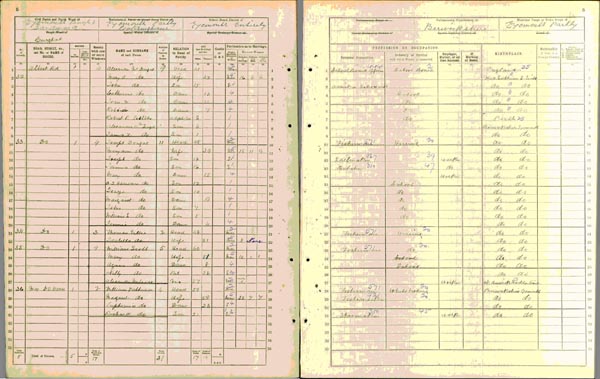1911 Census
1911 Census
The 1911 Census was taken on Sunday 2 April under provisions in the Census (Great Britain) Act 1910. The records were released on 5 April 2011 following the end of their 100 year closure period.
The population of Scotland on 2 April 1911 was 4,760,904. 
The 1911 census records of England, Wales and Ireland are the original schedules as completed by heads of households, institutions and vessels.
The Scottish records are the enumeration books which contain information transcribed from the household schedules as with all previous censuses back to 1841. They are made available as full colour images.
The Scottish household schedules were destroyed after the completion of work on the census.
This guide covers:
- 1911 census questions
- 1911 census enumerators’ instructions
- 1911 census punch card tabulation and the staff involved
- 1911 census occupations
- 1911 census street indexes
1911 Census Questions
There were new questions relating to fertility of marriage: on duration of marriage; the number of living children born to each marriage; and the number alive at the time of the census.
There were changes to several others:
- categories for people with disabilities were revised and the introductory section to the third report on the 1911 census refers to the intended use of the terms as:
- lunatic - in cases where the infirmity had been acquired during life
- imbecile - in extreme cases where the infirmity had existed from birth or an early age
- feeble-minded - in milder cases where the infirmity had existed from birth or an early age.
- the question on occupation was extended to find out which industries or services a worker was connected to in addition to their personal profession or occupation
- the question on place of birth was extended to include nationality for those born in a foreign country, that is, outwith British territory, colonies and dependencies.
In this example from 1911 Census for the district of Eyemouth in Berwickshire (our reference 1911/739/1, page 5) you can see that with the additional columns the entries now span two pages in the enumeration book. Click on the image to view it full size.
1911 Census Instructions
The guide ‘Instructions to local officers as to their duties in taking the census’ (pdf) shows that the police were asked to assist with the enumeration of persons in barns, sheds, caravans, tents and in the open air.
Suffragettes were active but the fine of £5 may have deterred them from refusing to take part in the census altogether. This detail from the 1911 Census for Hoprig Mains, Gladsmuir in East Lothian (our reference 1911/708/3, page 12) includes an entry for Catherine Blair, founder of the Scottish Women’s Rural Institutes, who gave her occupation as farmer’s wife (suffragette).

1911 Census Punch Card Tabulation and the Staff Involved
A mechanical system of punch card tabulation was used for the first time. The Census Office in Edinburgh hired Hollerith machines which had been used successfully in the United States of America for their 1890 Census. This speeded up processing and allowed for the publication of more detailed tables.
Census (Scotland) 1911 - Card Punching Staff – Names and Record of Service (pdf) is taken from the Census Office establishment book (our reference GRO4/27/2). The final entry for the boy messenger, Walter Urquhart, shows that he served as a private in the First World War and had been reported missing in action. For further information please go to the Gallipoli 28 June 1915 page in the First World War section of this website.
1911 Census Occupations
1911 Census report, volume II includes an index to occupations (pages 437-445) which is available on Histpop - the Online Historical Population Reports website.
1911 Census Street Indexes
Census street indexes provide registration district (RD) and enumeration district (ED) references for each street in a city or urban area. They also cover institutions such as asylums, hospitals, workhouses, prisons, police stations and barracks as well as hotels and public buildings.
There are 31 street indexes for the 1911 census. They have been digitised and are made available as pdf files that are several megabytes in size.
If you can’t find a particular street it may not have existed in 1911 or may have had a different name.
- Aberdeen
- Ayr
- Bonhill
- Bothkennar, Grangemouth and Polmont
- Bothwell, Holytown and Bellshill
- Cambusnethan
- Dalziel
- Dumfries
- Dunbarton
- Dundee
- Dunfermline
- East and West Calder
- Edinburgh
- Falkirk
- Glasgow
- Greenock, Gourock and Port Glasgow
- Hamilton
- Hawick
- Inverness
- Kilmarnock
- Kirkcaldy and Dysart
- Lewis and Harris
- Montrose
- New Kilpatrick
- New Monkland
- Old Kilpatrick
- Old Monkland - Western District, Coatbridge and Old Monkland - Eastern District
- Paisley, Johnstone and Elderslie
- Perth
- Skye
- St Ninians
- Stirling
